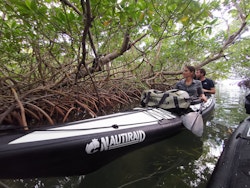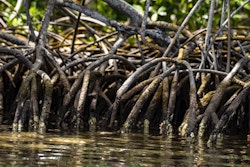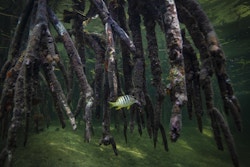Mangroves, a biodiversity refuge in danger
A unique forest adapted to the extreme salinity of the marine environment, a carbon sink, a complex ecosystem and a fish nursery: the role of mangroves is multiple and essential for the survival of many plant and animal species. However, more than 35% of all mangroves have disappeared in the last 20 years worldwide.
We take advantage of the presence of our crew in Guadeloupe to share an inventory of mangroves today and why it is urgent to protect them. By Katia Nicolet, scientific advisor on board Energy Observer.

Exploration in the Mangroves
Tell me about mangroves
A mangrove is a tree or a shrub that lives along coastlines and have the capability of growing within reach of the tides. Some species of mangrove trees live so close to the shoreline that they are flooded with salt water every day. All these plants, which are not necessarily closely related, have evolved special adaptations to enable them to live in salty and oxygen-poor soil.
Under this definition, there are about 54 species of mangroves belonging to 16 different families. These are found in tropical and subtropical coastal areas across the globe, roughly between 25˚ north and 25˚ south. The limiting factor for the mangrove distribution is temperature, these plants cannot survive freezing temperatures even for a few hours.

Mangroves in Guadeloupe
Species adaptation: a salty problem
Very few plants can live in salt rich environments, because the salt in the seawater causes the water inside the plant cells to exit, drying the tissues and causing the death of the plant. This process is called osmosis, where water moves from areas low in salt concentration (plant cell) to areas high in salt (seawater) to equalise both solutions. But mangrove trees can drink up saltwater and survive. How?
Different species use different methods for dealing with salt, some are “secretos” and actively rid their tissue of salt, and others are “non-secretors” and prevent the salt from entering their tissue in the first place. Some species are so efficient at filtering seawater that up to 90% of the salt is excluded. The water inside the plant is thus “fresh” and no osmosis issue arises. Most mangrove however, deal with the salt once inside –they are the secretors.
Avicennia species, for example, push salt from seawater out through special salt glands within their leaves. You can see the salt crystals accumulating on their leaves until rain washes them away. Other species accumulate the extra salt in specific leaves, charging them until they turn yellow and fall off, taking the salt with them.
Looking for oxygen
The soil in mangrove habitats pose a second challenge as it is poor in oxygen. All plants need to “breath”, exchanging gases through their roots, using air pockets in the soil. However, the water-filled mud surrounding mangroves roots does not allow for gas exchange, and to make matters worse, mangrove roots are flooded with seawater up to two times a day. To survive these conditions, mangroves keep their roots close to the surface to quickly access oxygen. Some species, like Rhizophora, extend long curved areal roots from their trunk, maximising the surface of the root that remains out of water and mud. These stilt roots are covered in small openings, the lenticels, that perform the respiration of the tree.
Other species have their root system under the soil’ surface but shoot vertical roots from the ground, just like snorkels sticking out of the water. These are called pneumatophores and are also covered in lenticels to allow breathing.
A major importance
Mangrove forests are the border between ocean and earth, protecting the shoreline from wave action and erosion. Their specific root systems break the energy from the waves and also permits the deposition of sand, dirt and silt particles in calmer waters. Pollutants and heavy metals are likewise deposited with the sediment particles, trapped in the muddy soil for years to come. Lastly, mangroves absorb nutrients from terrestrial runoff and stop them from reaching the marine environment, keeping nearby ecosystems, like coral reefs and seagrass beds, healthy.
Mangrove forests are also incredibly important for their carbon storage. As the trees grow, they absorb carbon from the atmosphere and transform it in solid organic matter to build their wood, roots and leaves –just like any other plant. Where mangrove forests are different is when they die, they fall into the oxygen-poor mud. The carbon in their decaying cells is buried and trapped, preventing its release into the atmosphere. It is estimated that mangrove forests across the globe store 34 million tons of carbon per year.
Lastly, mangrove habitats are a true nursery for many species of fish and a home for birds, reptiles, fish, crustaceans and other invertebrates. This exceptional biodiversity is a source of endless riches for human populations. Besides the food the ecosystem provides, products from mangroves also include wood for constructions, charcoal, derivatives for soaps, cosmetics, perfumes and insecticides as well as important compounds for medical drugs and treatments. For all these services mangroves provide, they are globally estimated being worth over 1600 billion dollars.
An ecosystem threatened by... shrimp farms
Mangroves around the world are disappearing at an alarming rate, over 35% of all mangrove habitats disappeared in the last 20 years. This rate varies from one region to the next, and some area already lost 70% of their mangrove cover. The biggest threat to these ecosystems is the emergence of shrimp farms, which is responsible for over a third of all the destruction. Moreover, the farming of shrimps hid other ecological costs. After the shrimps have reached their desired size, the ponds are drained to ease the harvest, releasing toxic water containing pesticides, chemicals, antibiotics and excess nutrients into the surrounding waters. Over a few years, the pond accumulates toxic waste despite cleaning efforts and must be abandoned. Where a rich, biodiverse and critical ecosystem once stood, only a polluted wasteland remains.
This destructive industry is a response to the increasing appetite for shrimp in Europe, China, Japan and the United States. In 1990, the production was of 13 million tonnes and increased to 74 million in 2019. The projections are even more frightening: 92 million by 2022.
Unfortunately, the harvest of wild shrimp is not a solution either, shrimp trawling nets scrap the ocean floor and catch between 60 and 98% of “bycatch” – unwanted species such as fish, sharks, turtles, crustaceans and corals. This results in tens of millions of tonnes of animals being killed and disregarded back into the sea every year.
What can we be done at individual scale?
In order to protect the future of mangroves and of the oceans, we, consumers, must realise the true value of the food in our plates. The market but also the ecological cost of what we eat every day. This does not necessarily mean that we must stop eating meat and seafood altogether, but we must reduce our overconsumption of these products. We need to see the streak, fish and shrimp in our plate as they truly are, a precious good.
We need to give the value back to the products we consume and think twice before buying frozen shrimps in the supermarket.

The mangroves from the sky
To go further
Mangroves: 11 facts you need to know - Conservation National
What is a "mangrove" forest? - National Ocean Service
Everything You Need to Know About Mangroves - Ocean Conservancy

